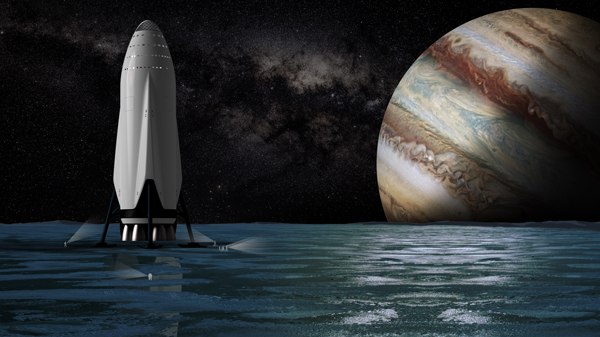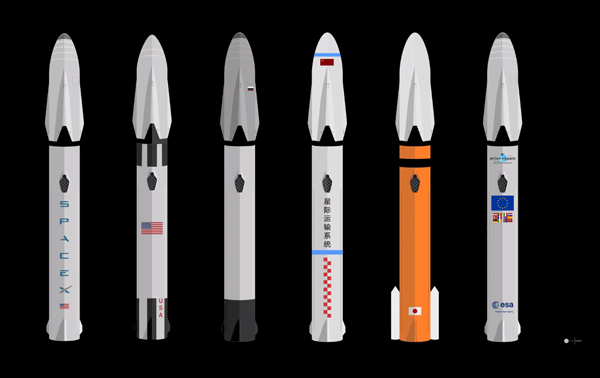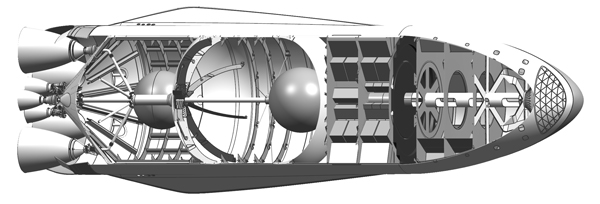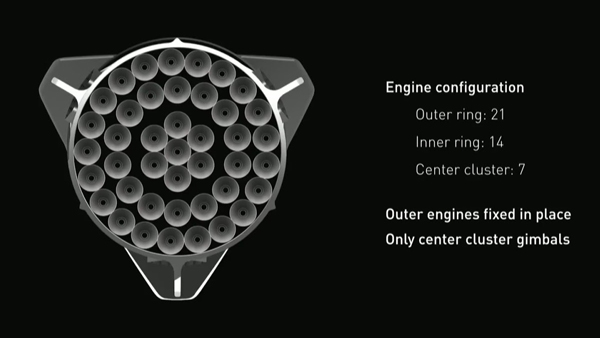SpaceX
History
In 2007, Musk stated a personal goal of eventually enabling human exploration and settlement of Mars. SpaceX began development of the Raptor rocket engine (the engine used in Starship) prior to 2014.
Mars Colonial Transporter (MCT)
In October 2012, Musk first publicly stated a plan to build a fully reusable rocket system with substantially greater capabilities than the Falcon 9. The idea comprised reusable rocket engines, launch vehicles and space capsules to transport humans to Mars and return them to Earth. The MCT vehicle was to be “an evolution of SpaceX’s Falcon 9 booster – only much bigger.
In February 2014, the principal payload for the MCT was announced to be a large interplanetary spacecraft, capable of carrying up to 100 tonnes of passengers and cargo. According to SpaceX engine development head Tom Mueller, SpaceX could use nine Raptor engines on a single rocket. The rocket would be at least 10 meters in diameter — nearly three times the diameter and over seven times the cross-sectional area of the Falcon 9 booster cores. It was expected to have up to three cores totalling at least 27 engines.
Interplanetary Transport System
In 2016, Musk abandoned the Mars Colonial Transporter name, as the system would be able to “go well beyond Mars”, in favour of Interplanetary Transport System (ITS). That year he unveiled details of the space mission architecture, launch vehicle, spacecraft, and Raptor engines. The first firing of a Raptor engine occurred on a test stand in September 2016.
In October 2016, Musk indicated that the initial prepreg carbon-fibre tank test article, built with no sealing liner, had performed well in cryogenic fluid testing. A pressure test at approximately 2/3 of the design burst pressure was completed in November 2016.
SpaceX initially envisioned a 12-meter-diameter ITS concept in 2016 solely aimed at Mars transit and other interplanetary uses. In 2017 it articulated a smaller 9-meter-diameter vehicle to replace all of its launch service provider capabilities—Earth-orbit; lunar-orbit; interplanetary missions; and potentially, even intercontinental passenger transport on Earth—but do so on a fully reusable set of vehicles with a markedly lower-cost structure.
In July 2017, Musk said that the architecture had evolved since 2016 in order to support commercial transport via Earth-orbit.
In 2018, the Starship system was redesigned to use stainless steel instead of carbon fiber construction, to improve performance while drastically decreasing cost.
Image: Digital Universe at hdwallpaperslife.com
Design
The ITS stack was composed of two stages. The first stage was to be a launch booster, while the second stages would be either an “Interplanetary Spaceship” for crewed transport or an “ITS tanker” for orbital refuelling. Both stages were to be powered by Raptors.
The Raptor was a bi-propellant liquid rocket engine in a full flow staged combustion cycle, with liquid methane fuel and liquid oxygen oxidizer. Both propellants would enter the combustion chamber in the gas phase. A bleed-off of the high-pressure gas would provide autogenous pressurisation of the propellant tanks, eliminating the Falcon 9’s problematic high-pressure helium pressurization system.
The overall launch vehicle height, (first and second stages), was 122m. Both stages were to have been constructed of lightweight carbon fiber, including the deep-cryogenic propellant tanks, a major change from the Falcon 9’s aluminium-lithium alloy tank and structure material. Both stages were to be fully reusable and land vertically. Gross liftoff mass was to be 10,500t at a lift-off thrust of 128 mega-newtons. ITS was to carry a payload to low Earth orbit of 550 tonnes in expendable mode and 300 tonnes in reusable mode.
Image: r/SpaceX at reddit.com
Image: spaceflight101.com
ITS Booster
The ITS booster was a 12m diameter, 77.5m high, reusable first stage, to be powered by 42 sea-level rated engines each producing some 3,024 kilo-newtons of thrust.
The engine configuration included 21 engines in an outer ring and 14 in an inner one. The centre cluster of seven engines was to be gimbled for directional control. Thrust on each engine was aimed to vary between 20 and 100 percent of rated thrust.
The propellants would also power the reaction control thrusters, while in the gas phase. These thrusters would control booster orientation in space and improve accuracy during landing.
The design goal was to achieve a separation velocity of approximately 8,650km/h while retaining about 7% of the initial propellant to achieve a vertical landing at the launch pad.
The design called for grid fins to guide the booster during atmospheric reentry. The booster return flights were expected to encounter loads lower than the Falcon 9, principally because the ITS would have both a lower mass ratio and a lower density.
In contrast to the landing method used on SpaceX’s mid-2010s reusable rocket, first stages, the ITS booster was to designed to land on the launch mount itself, for immediate refuelling and relaunch.
Image: humanmars.net
Second Stage
The ITS did not have a dedicated single-function second stage for achieving orbit. Instead, the second stage function of reaching orbit was a secondary role for a spacecraft capable of long-duration spaceflight.
The Interplanetary Spaceship was a large passenger-carrying spacecraft design proposed in September 2016. The ship would operate as a second-stage and as an interplanetary transport vehicle for cargo and passengers. The Interplanetary Spaceship would be able to transport up to 450 tonnes per trip to Mars following refuelling in Earth orbit. The three sea-level Raptor engines would be used for manoeuvring, descent and landing, as well as an initial ascent from the Mars surface.
The ITS tanker was a second stage propellant tanker variant. It was designed to transport up to 380 tonnes of propellants to low Earth orbit to refuel Interplanetary Spaceships. After refuelling operations, it was to land and be prepared for another flight.
Re-usability
Both stages were to be designed to be fully reusable and were to land vertically, using Falcon 9 generation technologies.
Importantly, the “fully and rapidly reusable” aspect of the ITS design was the largest factor in the SpaceX analysis for reducing the cost of transporting mass to space. While the 2016-17 system under development relied on several cost-reducing elements, re-usability alone was claimed to reduce that cost by approximately 2 1/2 orders of magnitude over NASA’s previous missions.




